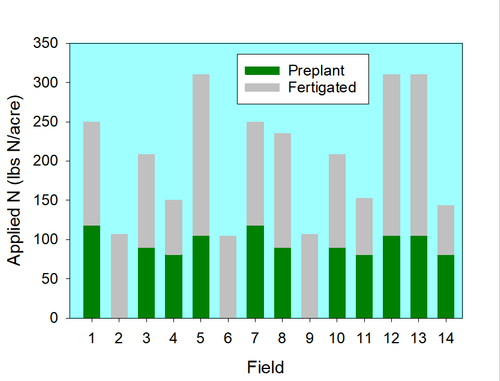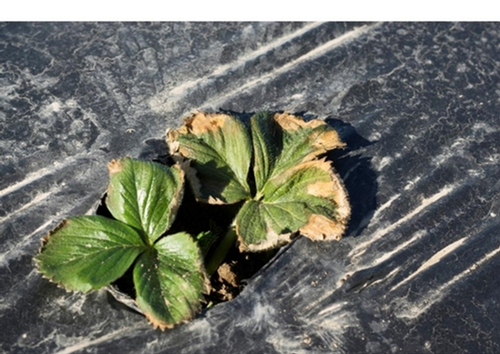Mark here - Mike presented this information at the "Mariscada meeting" held by Gerry Spinelli a couple of weeks ago. Excellent meeting by the way, but with very few people in attendance. One part in particular, this being the necessity of a certain soil N concentration early in the season even though the plant requirements are low since it is small, presented by Mike on nitrogen management of strawberry transplants really caught my attention, so I asked him to write that up for all of us. He graciously offered to do this, and his summary appears here. Thanks Mike!
Nitrogen Management of Strawberry during Establishment and Early Season
Growers follow a number of strategies for managing nitrogen during the early season. Some apply almost half of the seasonal nitrogen required by strawberry as preplant fertilizer before transplanting while others skip preplant fertilizer or use a reduced rate (Fig. 1). Others use controlled release fertilizers while some growers opt for conventional fertilizer products. These decisions are based on grower experience, cultivar, soil type, and anticipated weather conditions. The following are a few concepts on early season N management for strawberry to consider as we enter a new season.
On the central coast the N needs of strawberry are quite modest for the first few months after transplanting. This is because growth rates are low until March when average temperature and day length begin to increase. For most varieties, strawberries will take up 20 to 30 lbs of N/acre during this period. However, new transplants have a very limited root system and need nitrogen to jump start root and shoot growth. A rule of thumb is to have 10 to 15 ppm mineral N (nitrate + ammonium) in the upper foot during the early season, which is equivalent to 35 to 60 lbs N/acre, depending on the soil texture. Usually most of the soil mineral N is in the nitrate form. Checking the soil at least monthly during the early season can help determine if supplemental fertilizer is needed, which can be applied through the drip system.
The decision to use preplant fertilizer may depend on several factors such as anticipated rainfall, soil texture, previous crop, and initial soil nitrate concentration. When following vegetables, the concentration of soil nitrate can be high (20 to 30 ppm NO3-N) and can supply a large portion of the early crop N needs if not leached out by irrigation and rainfall. In contrast, the level of soil nitrate maybe low when planting after a strawberry crop (< 5 ppm NO3-N), and the transplants may need some fertilizer nitrogen to simulate root and shoot growth.
Soil type and anticipated rainfall should also be considered in deciding whether to use preplant fertilizer. Even with plastic mulch, a strawberry crop planted on a sandy soil could lose much of the soil nitrate during heavy rain events. On the other hand, preplant fertilizer may increase salinity near the root system, especially if it is banded near the plant row and rainfall is light during the winter (Fig. 2 below). Controlled released fertilizers are more expensive than conventional fertilizers but can be a good option if soil nitrate is low at transplanting and the release rate of the fertilizer matches the N uptake rate of the crop.
Also consider the nitrogen contribution of other sources of N to the crop. High nitrate irrigation water can supply much of the N needs of the crop in early season, especially during a dry year when the crop is frequently irrigated. Recycled water can also contain a significant amount of nitrogen as both nitrate-N and ammonium-N. More information on how to credit the N in irrigation water can be found in the Salinas Valley Blog. https://ucanr.edu/blogs/blogcore/postdetail.cfm?postnum=7744 Added organic amendments and soil organic matter can also play a role in supplying N, depending on soil temperatures during the winter.
Because there can be several factors that affect soil nitrate levels during the early season, we recommend evaluating the soil nitrate concentration at least once per month and making adjustments by fertigating as needed. This approach provides flexibility so that the reliance on preplant fertilizer can be less without risking crop yield loss. The soil nitrate quick test is an accurate and easy tool to use that can allow growers to monitor soil nitrate. More information on using the soil nitrate test can be found on the Salinas Agriculture Blog. https://ucanr.edu/blogs/blogcore/postdetail.cfm?postnum=4406
In summary, multiple approaches to N management can work for strawberry because the N demand is low during the early season, and the combination of residual soil nitrate, N mineralization from soil and amendments, and nitrate in the irrigation water can often supply much of the N that the crop needs to become established.
Attached Images:

